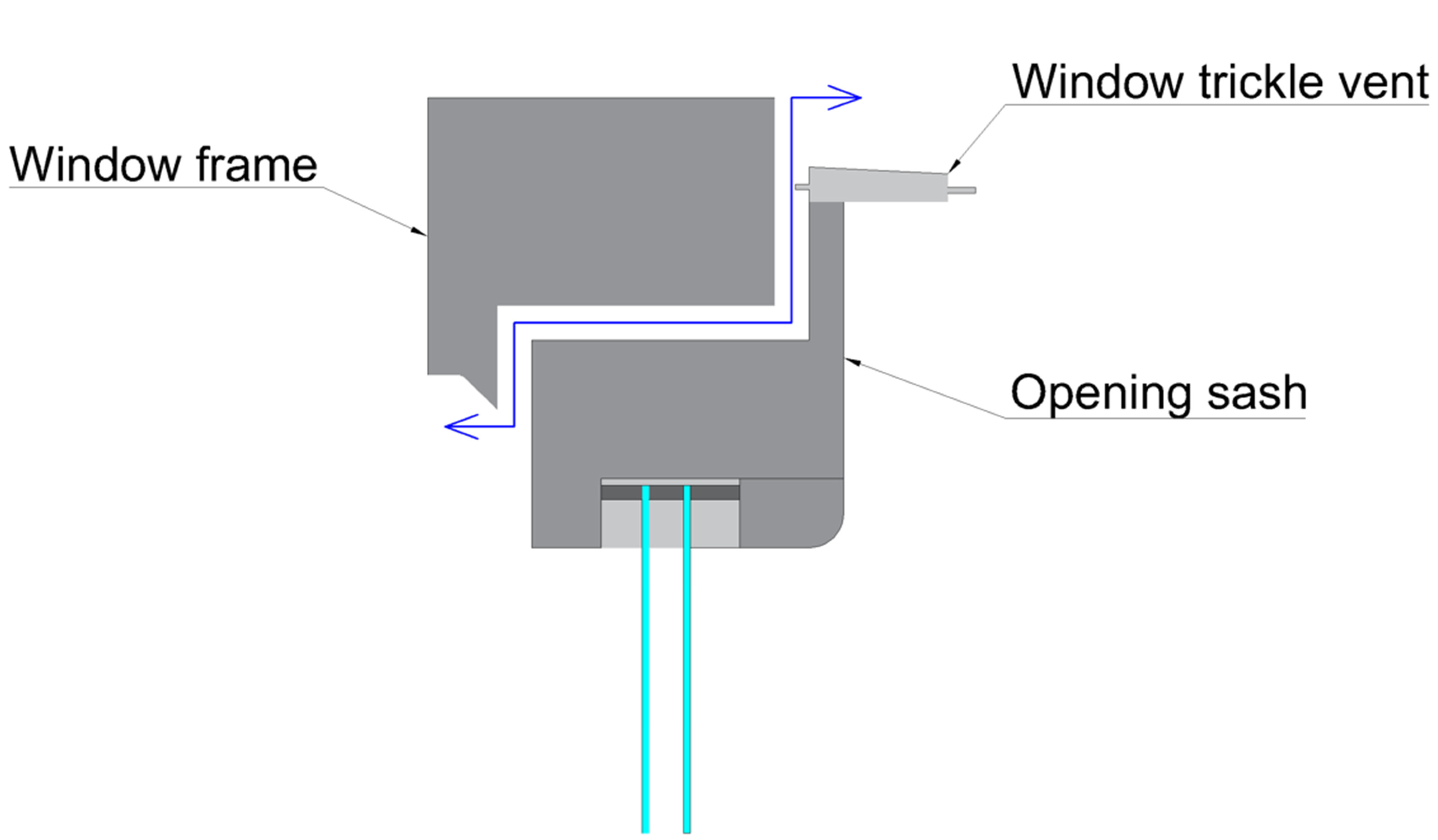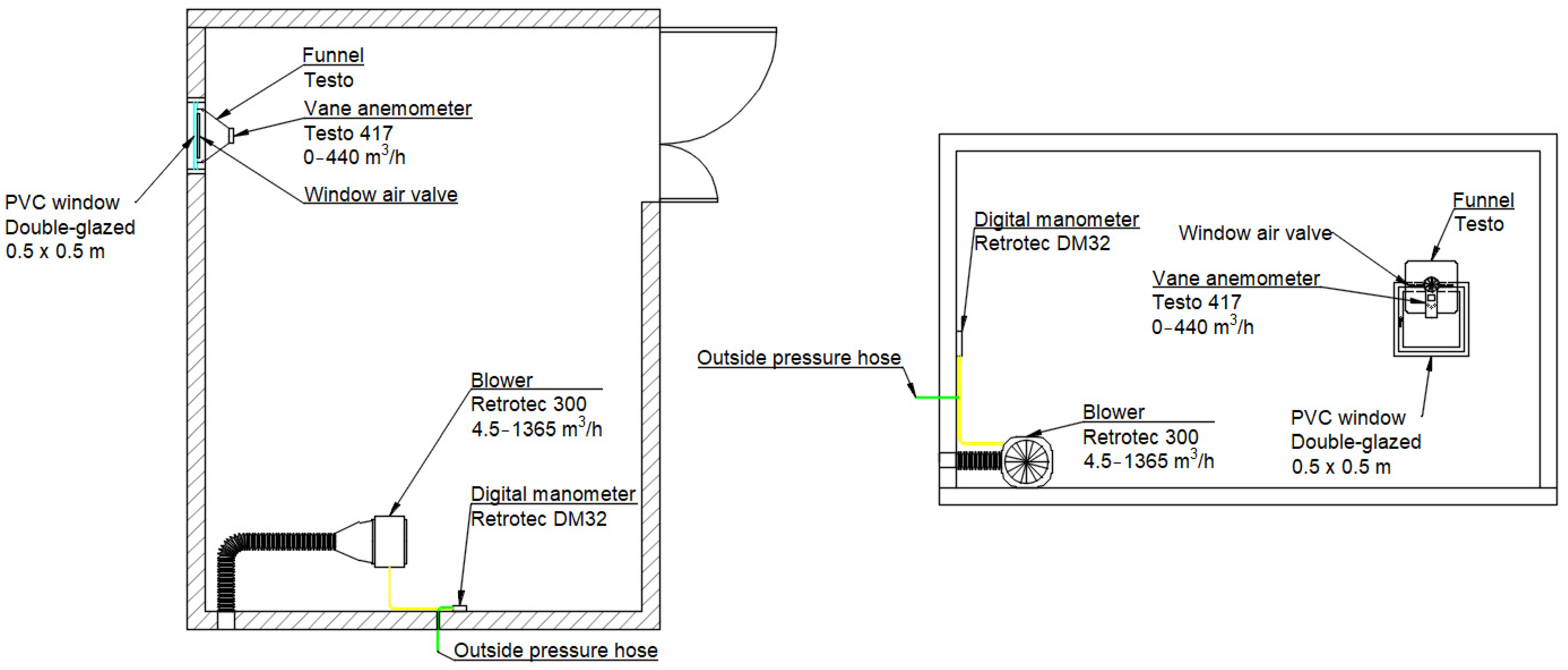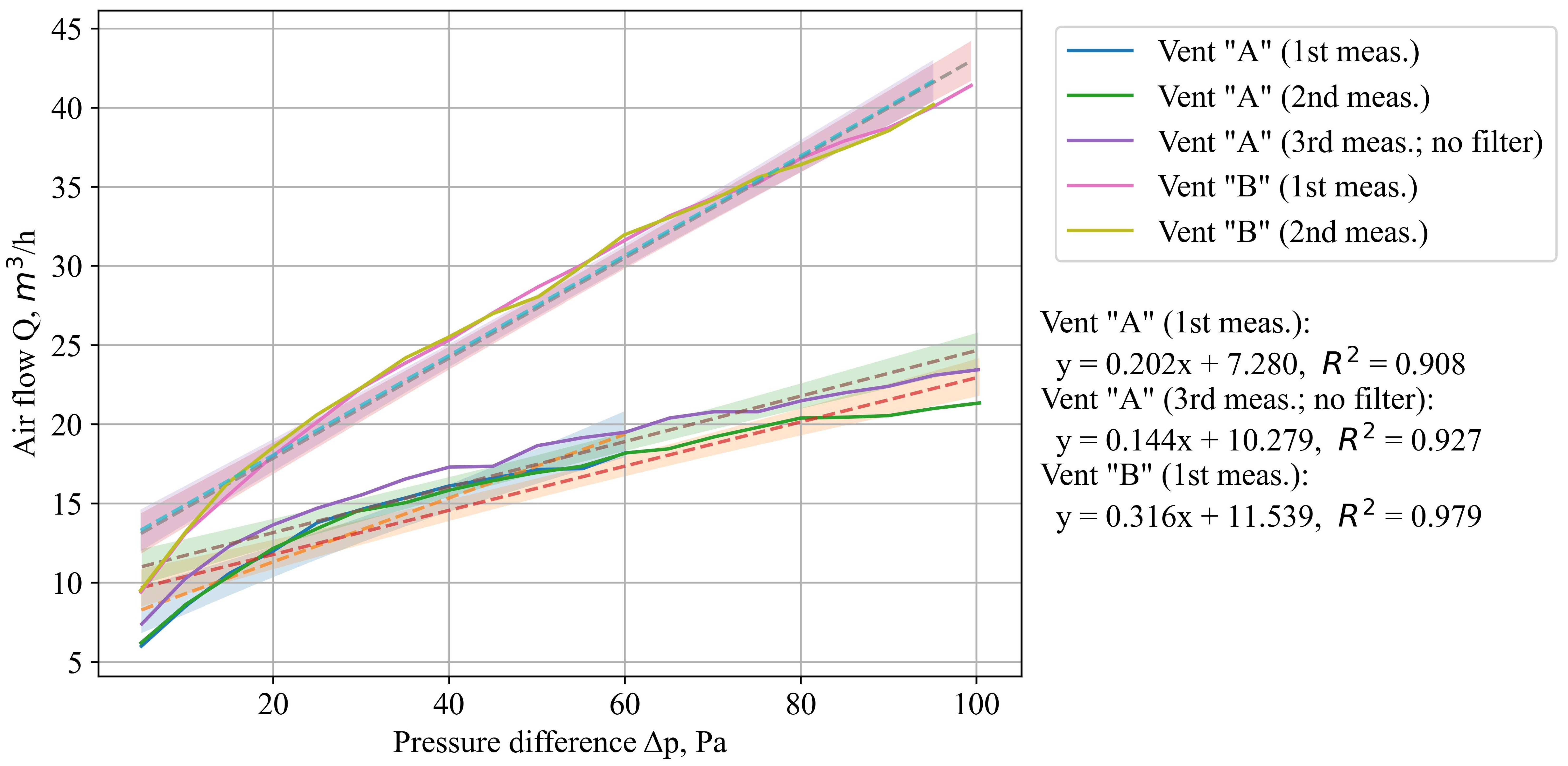Analysis of Window Trickle Vents at Various Pressure Differences
Abstract
1. Introduction
1.1. Public-Health Context
1.2. Regulatory Framework and Ventilation Targets
1.3. Natural and Hybrid Ventilation: Physical Drivers and Constraints
1.4. Trickle Vents: Definition, Typologies, and Prior Evidence
1.5. Research Gap, Objectives, and Contributions
2. Materials and Methods
3. Results
4. Discussion
4.1. Temperature and Real-World Variability
4.2. Limitations and Future Work
5. Conclusions
Author Contributions
Funding
Institutional Review Board Statement
Informed Consent Statement
Data Availability Statement
Conflicts of Interest
Abbreviations
| IAQ | Indoor Air Quality |
| SBS | Sick Building Syndrome |
| MAV | Multi-vent Module-based Adaptive Ventilation |
| PWVO | Passive Window Ventilation Openings |
| Q | Air Flow, m3/h |
| ∆p | Pressure difference, Pa |
| Cd | Discharge coefficient |
| A | Effective flow area of the opening, m2 |
| Δpstack | Buoyancy-driven (stack) component of Δp, Pa |
| p | Air density, kg/m3 |
| pin, pout | Indoor and outdoor air density, kg/m3 |
| pref | Air density at the reference state, kg/m3 |
| p | Atmospheric (static) pressure, Pa |
| H | Height, m |
| g | Gravitational acceleration, ≈9.81m/s2 |
References
- Guyot, G.; Sherman, M.H.; Walker, I.S. Smart ventilation energy and indoor air quality performance in residential buildings: A review. Energy Build. 2018, 165, 416–430. [Google Scholar] [CrossRef]
- World Health Organization (WHO). Household Air Pollution. Available online: https://www.who.int/news-room/fact-sheets/detail/household-air-pollution-and-health (accessed on 4 July 2023).
- Redlich, C.A.; Sparer, J.; Cullen, M.R. Sick-building syndrome. Lancet 1997, 349, 1013–1016. [Google Scholar] [CrossRef] [PubMed]
- Joshi, S. The sick building syndrome. Indian J. Occup. Environ. Med. 2008, 12, 61–64. [Google Scholar] [CrossRef] [PubMed]
- Fan, L.; Ding, Y. Research on risk scorecard of sick building syndrome based on machine learning. Build. Environ. 2022, 211, 108710. [Google Scholar] [CrossRef]
- Mosallaei, S.; Hashemi, H.; Hoseini, M.; Dehghani, M.; Naz, A. Polycyclic Aromatic Hydrocarbons (PAHs) in household dust: The association between PAHs, Cancer Risk and Sick Building Syndrome. Build. Environ. 2023, 229, 109966. [Google Scholar] [CrossRef]
- Shao, Z.; Bi, J.; Yang, J.; Ma, Z. Indoor PM2.5, home environmental factors and lifestyles are related to sick building syndrome among residents in Nanjing, China. Build. Environ. 2023, 235, 110204. [Google Scholar] [CrossRef]
- Zemitis, J.; Borodinecs, A.; Lauberts, A. Ventilation impact on VOC concentration caused by building materials. Mag. Civ. Eng. 2018, 84, 130–139. [Google Scholar] [CrossRef]
- Zhang, S.; Ai, Z.; Lin, Z. Novel demand-controlled optimization of constant-air-volume mechanical ventilation for indoor air quality, durability and energy saving. Appl. Energy 2021, 293, 116954. [Google Scholar] [CrossRef]
- Borodinecs, A.; Zemitis, J.; Kreslins, A.; Gaujena, B. Determination of optimal air exchange rate to provide optimal IAQ. In Proceedings of the 10th International Conference on Healthy Buildings 2012, Brisbane, Australia, 8–12 July 2012. [Google Scholar]
- Asdrubali, F.; Baldinelli, G.; Bianchi, F.; Cornicchia, M. Experimental Performance Analyses of a Heat Recovery System for Mechanical Ventilation in Buildings. Energy Procedia 2015, 82, 465–471. [Google Scholar] [CrossRef]
- EN 16798-1:2021; Energy Performance of Buildings. Ventilation for Buildings. Part 1: Input Parameters for Indoor Climate for the Design and Assessment of the Energy Performance of Buildings, Taking into Account Indoor Air Quality, Temperature Regime, Lighting and Acoustics. Module M1-6. European Committee for Standardization: Brussels, Belgium, 2021.
- Delwati, M.; Merema, B.; Breesch, H.; Helsen, L.; Sourbron, M. Impact of demand controlled ventilation on system performance and energy use. Energy Build. 2018, 174, 111–123. [Google Scholar] [CrossRef]
- Zemitis, J.; Borodinecs, A.; Geikins, A.; Kalamees, T.; Kuusk, K. Ventilation System Design in Three European Geo Cluster. Energy Procedia 2016, 96, 285–293. [Google Scholar] [CrossRef][Green Version]
- Xie, X.; Luo, Z.; Grimmond, S.; Sun, T. Impact of building density on natural ventilation potential and cooling energy saving across Chinese climate zones. Build. Environ. 2023, 244, 110621. [Google Scholar] [CrossRef]
- Kaye, N.B.; Hunt, G.R. Heat source modelling and natural ventilation efficiency. Build. Environ. 2007, 42, 1624–1631. [Google Scholar] [CrossRef]
- Miragaya, P.G.; Leal, T.E.; Saade, L.P.; Caballero, R.T. The CO2 assessment in a school classroom for an optimal natural ventilation strategy = The CO2 assessment in a school classroom for an optimal natural ventilation strategy. Build. Manag. 2021, 5, 29–43. [Google Scholar] [CrossRef]
- Zemitis, J.; Terekh, M. Management of energy efficient measures by buildings’ thermorenovation. MATEC Web Conf. 2018, 245, 06003. [Google Scholar] [CrossRef][Green Version]
- Ji, Y.; Duanmu, L.; Liu, Y.; Dong, H. Air infiltration rate of typical zones of public buildings under natural conditions. Sustain. Cities Soc. 2020, 61, 102290. [Google Scholar] [CrossRef]
- Deshko, V.; Bilous, I.; Sukhodub, I.; Yatsenko, O. Evaluation of energy use for heating in residential building under the influence of air exchange modes. J. Build. Eng. 2021, 42, 103020. [Google Scholar] [CrossRef]
- Prozuments, A.; Borodinecs, A.; Bajare, D. Trombe Wall System’s Thermal Energy Output Analysis at a Factory Building. Energies 2023, 16, 1887. [Google Scholar] [CrossRef]
- Jiang, Y.; Chen, Q. Study of natural ventilation in buildings by large eddy simulation. J. Wind. Eng. Ind. Aerodyn. 2001, 89, 1155–1178. [Google Scholar] [CrossRef]
- Sakulpipatsin, P.; Boelman, E.C.; Cauberg, H. Heat recovery in residential ventilation systems from an exergy perspective. Healthy Build. 2006, 5, 269–274. [Google Scholar]
- Fernández-Agüera, J.; Campano, M.Á.; Domínguez-Amarillo, S.; Acosta, I.; Sendra, J.J. CO2 concentration and occupants’ symptoms in naturally ventilated schools in mediterranean climate. Buildings 2019, 9, 197. [Google Scholar] [CrossRef]
- Buyak, N.; Deshko, V.; Bilous, I. Changing Energy and Exergy Comfort Level after School Thermomodernization. Rocz. Ochr. Sr. 2021, 23, 458–469. [Google Scholar] [CrossRef]
- Deshko, V.; Bilous, I.; Buyak, N.; Shevchenko, O. The Impact of Energy-Efficient Heating Modes on Human Body Exergy Consumption in Public Buildings. In Proceedings of the 2020 IEEE 7th International Conference on Energy Smart Systems (ESS), Kyiv, Ukraine, 12–14 May 2020; IEEE: Piscataway, NJ, USA; pp. 201–205. [Google Scholar] [CrossRef]
- Rajagopalan, P.; Luther, M.B. Thermal and ventilation performance of a naturally ventilated sports hall within an aquatic centre. Energy Build. 2013, 58, 111–122. [Google Scholar] [CrossRef]
- Prozuments, A.; Borodinecs, A.; Bebre, G.; Bajare, D. A Review on Trombe Wall Technology Feasibility and Applications. Sustainability 2023, 15, 3914. [Google Scholar] [CrossRef]
- Lyu, X.; Xu, Y.; Wei, M.; Wang, C.; Zhang, G.; Wang, S. Effects of vent opening, wind speed, and crop height on microenvironment in three-span arched greenhouse under natural ventilation. Comput. Electron. Agric. 2022, 201, 107326. [Google Scholar] [CrossRef]
- Higton, T.D.; Burridge, H.C.; Hughes, G.O. Natural ventilation flows established by a localised heat source in a room with a doorway and a high-level vent. Build. Environ. 2021, 203, 108093. [Google Scholar] [CrossRef]
- Castillo, J.A.; Tovar, R.; Huelsz, G. Natural ventilation in a room with a horizontal cylindrical heat source, a window and bottom or top vents. Build. Environ. 2021, 191, 107583. [Google Scholar] [CrossRef]
- Zhang, J.; Lu, S.; Li, C.; Yuen, R.K.K. Vent Location Impacts on Building Compartment Fire under Natural Roof Ventilation. APCBEE Procedia 2014, 9, 360–364. [Google Scholar] [CrossRef]
- Fitzgerald, S.D.; Woods, A.W. Natural ventilation of a room with vents at multiple levels. Build. Environ. 2004, 39, 505–521. [Google Scholar] [CrossRef]
- Zhang, H.; Zhang, W.; Zhang, W.; Xuan, Y.; Yue, Y. Multi-vent module-based adaptive ventilation to reduce cross-contamination among indoor occupants. Build. Environ. 2022, 212, 108836. [Google Scholar] [CrossRef]
- Molkov, V.; Shentsov, V.; Quintiere, J. Passive ventilation of a sustained gaseous release in an enclosure with one vent. Int. J. Hydrogen Energy 2014, 39, 8158–8168. [Google Scholar] [CrossRef]
- Zakovorotnyi, A.; Tadlia, O.; Krukovsky, P. Energy Efficiency of Short-Term Natural Room Ventilation. In Proceedings of the REHVA Annual Conference “Advanced HVAC and Natural Gas Technologies”, Riga, Latvia, 6–9 May 2015; Riga Technical University: Riga, Latvia, 2015; p. 201. [Google Scholar] [CrossRef][Green Version]
- Franco, A.; Schito, E. Definition of optimal ventilation rates for balancing comfort and energy use in indoor spaces using CO2 concentration data. Buildings 2020, 10, 135. [Google Scholar] [CrossRef]
- Cabovská, B.; Bekö, G.; Teli, D.; Ekberg, L.; Dalenbäck, J.-O.; Wargocki, P.; Psomas, T.; Langer, S. Ventilation strategies and indoor air quality in Swedish primary school classrooms. Build. Environ. 2022, 226, 109744. [Google Scholar] [CrossRef]
- Biler, A.; Tavil, A.U.; Su, Y.; Khan, N. A Review of Performance Specifications and Studies of Trickle Vents. Buildings 2018, 8, 152. [Google Scholar] [CrossRef]
- Hoffmann, C.; Geissler, A.; Hauri, C.; Huber, H. Passive window ventilation openings in every-day use. Build. Environ. 2021, 206, 108259. [Google Scholar] [CrossRef]
- Yang, Y.; Wang, Z.; Li, X.; Zhao, D.; Zuo, J.; Ren, Y.; Lyu, W.; Xu, Z. Investigating the impact of stack effect on ventilation performance of residential kitchen exhaust shaft system. Energy Build. 2023, 296, 113364. [Google Scholar] [CrossRef]
- Brinks, P.; Kornadt, O.; Oly, R. Air infiltration assessment for industrial buildings. Energy Build. 2015, 86, 663–676. [Google Scholar] [CrossRef]
- Karava, P.; Stathopoulos, T.; Athienitis, A.K. Investigation of the performance of trickle ventilators. Build. Environ. 2003, 38, 981–993. [Google Scholar] [CrossRef]
- Choi, Y.; Song, D. How to quantify natural ventilation rate of single-sided ventilation with trickle ventilator? Build. Environ. 2020, 181, 107119. [Google Scholar] [CrossRef]
- Filis, V.; Kolarik, J.; Smith, K.M. The impact of wind pressure and stack effect on the performance of room ventilation units with heat recovery. Energy Build. 2021, 234, 110689. [Google Scholar] [CrossRef]
- Shi, Y.; Li, X. Effect of mechanical ventilation on infiltration rate under stack effect in buildings with multilayer windows. Build. Environ. 2020, 170, 106594. [Google Scholar] [CrossRef]
- Briga-Sá, A.; Paiva, A.; Lanzinha, J.-C.; Boaventura-Cunha, J.; Fernandes, L. Influence of Air Vents Management on Trombe Wall Temperature Fluctuations: An Experimental Analysis under Real Climate Conditions. Energies 2021, 14, 5043. [Google Scholar] [CrossRef]
- Mikola, A.; Simson, R.; Kurnitski, J. The impact of air pressure conditions on the performance of single room ventilation units in multi-story buildings. Energies 2019, 12, 2633. [Google Scholar] [CrossRef]
- ASHRAE. ASHRAE Handbook—Fundamentals; ASHRAE: Peachtree Corners, GA, USA, 2017. [Google Scholar]
- Borodinecs, A.; Gaujena, B.; Zemitis, J.; Kreslins, A. The stack effect influence on air exchange rate and IAQ in dwelling buildings. In Proceedings of the 12th International Conference on Indoor Air Quality and Climate 2011, Austin, TX, USA, 5–10 June 2011. [Google Scholar]




| Flow | Range |
|---|---|
| Maximum Flow | 1365.8 m3/h |
| Minimum Flow (102 mm flow range rings) | 279.1 m3/h |
| Minimum Flow (74 mm flow range rings) | 47.4 m3/h |
| Minimum Flow (47 mm flow range rings) | 21.2 m3/h |
| Minimum Flow (29 mm flow range rings) | 8.8 m3/h |
| Flow Accuracy | ±3% |
| Digital gauge model | DM32 |
| Parameter | Range |
|---|---|
| Pressure measuring | −2488 Pa to +2488 Pa |
| Accuracy | ±0.4% of pressure reading or ±0.07 Pa at 22 °C |
| ±0.6% of pressure reading or ±15 Pa at 0–44 °C | |
| ±0.9% of pressure reading or ±1 Pa at 70 °C | |
| Resolution | 0.1 Pa |
| Parameter | Volume Flow |
|---|---|
| Volume flow measuring range | 0 to 99,999 m3/h |
| Volume flow resolution | 0.1 m3/h (0 to 99.9 m3/h) |
| 1 m3/h (100 to 99,999 m3/h) | |
| Flow speed measuring range | 0.3 to 20 m/s |
| Flow speed accuracy ±1 digit | ±(0.1 m/s + 1.5% of m.v.) |
| Flow speed resolution | 0.01 m/s |
| I | II | III | IV | V | VI | VII | VIII | IX | X | XI | XII | |
|---|---|---|---|---|---|---|---|---|---|---|---|---|
| 1st floor | 23 | 21 | 19 | 15 | 11 | 9 | 7 | 8 | 12 | 16 | 21 | 23 |
| 9th floor | −1 | −3 | −1 | 1 | 2 | 4 | 4 | 4 | 4 | 4 | 3 | 1 |
Disclaimer/Publisher’s Note: The statements, opinions and data contained in all publications are solely those of the individual author(s) and contributor(s) and not of MDPI and/or the editor(s). MDPI and/or the editor(s) disclaim responsibility for any injury to people or property resulting from any ideas, methods, instructions or products referred to in the content. |
© 2025 by the authors. Licensee MDPI, Basel, Switzerland. This article is an open access article distributed under the terms and conditions of the Creative Commons Attribution (CC BY) license (https://creativecommons.org/licenses/by/4.0/).
Share and Cite
Palcikovskis, A.; Lebedeva, K.; Zemitis, J.; Borodinecs, A.; Prozuments, A. Analysis of Window Trickle Vents at Various Pressure Differences. Sustainability 2025, 17, 9304. https://doi.org/10.3390/su17209304
Palcikovskis A, Lebedeva K, Zemitis J, Borodinecs A, Prozuments A. Analysis of Window Trickle Vents at Various Pressure Differences. Sustainability. 2025; 17(20):9304. https://doi.org/10.3390/su17209304
Chicago/Turabian StylePalcikovskis, Arturs, Kristina Lebedeva, Jurgis Zemitis, Anatolijs Borodinecs, and Aleksejs Prozuments. 2025. "Analysis of Window Trickle Vents at Various Pressure Differences" Sustainability 17, no. 20: 9304. https://doi.org/10.3390/su17209304
APA StylePalcikovskis, A., Lebedeva, K., Zemitis, J., Borodinecs, A., & Prozuments, A. (2025). Analysis of Window Trickle Vents at Various Pressure Differences. Sustainability, 17(20), 9304. https://doi.org/10.3390/su17209304








